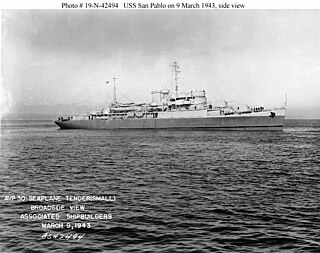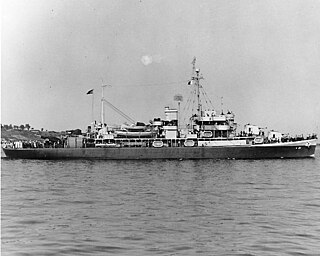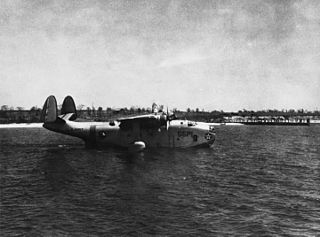
On September 3, 1939, the British and French declarations of war on Germany initiated the Battle of the Atlantic. The United States Navy Chief of Naval Operations (CNO) established a combined air and ship patrol of the United States Atlantic coast, including the Caribbean, on 4 September, President Franklin D. Roosevelt declared the United States' neutrality on 5 September, and declared the naval patrol a Neutrality Patrol. Roosevelt's initiation of the Neutrality Patrol, which in fact also escorted British ships, as well as orders to U.S. Navy destroyers first to actively report U-boats, then "shoot on sight", meant American neutrality was honored more in the breach than observance.

USS Goldsborough (DD-188/AVP-18/AVD-5/APD-32) was a Clemson-class destroyer in the United States Navy during World War II. She was the second Navy ship named for Rear Admiral Louis M. Goldsborough (1805–1877). Entering service in 1920, the ship had a brief active life before being placed in reserve in 1922. Goldsborough was reactivated for World War II and was used as an aircraft tender, destroyer and high speed transport in both Atlantic and Pacific theaters. Following the war, the ship was sold for scrapping in 1946.

USS Williamson (DD-244/AVP-15/AVD-2/APD-27) was a Clemson-class destroyer in the United States Navy during World War II. She was named for Commander William Price Williamson.

USS San Pablo (AVP-30) was a United States Navy Barnegat-class seaplane tender which was in commission as such from 1943 to 1947 and then served as a commissioned hydrographic survey ship, redesignated AGS-30, from 1948 to 1969. Thus far, she has been the only ship of the United States Navy to be named for San Pablo Bay, a shallow northern extension of San Francisco Bay in California.

USS Lapwing (AM-1/AVP-1) was the lead ship of her class of minesweeper – the first minesweeper of the United States Navy. She was named after a bird, the lapwing, an abundant crested plover of Europe, Asia, and northern Africa, noted for its slow, irregular, flapping flight and its shrill wailing cry.

USS Heron (AM-10) was an Lapwing-class minesweeper acquired by the United States Navy for the dangerous task of removing mines from minefields laid in the water to prevent ships from passing.

USS Thrush (AM-18) was a Lapwing-class minesweeper acquired by the United States Navy for the dangerous task of removing mines from minefields laid in the water to prevent ships from passing.

USS Teal (AM-23/AVP-5) was a Lapwing-class minesweeper acquired by the United States Navy for the task of removing naval mines from minefields laid in the water to prevent ships from passing. The ship entered service in 1918, was converted into a seaplane tender in the 1920s and took part in World War II, serving primarily in Alaskan waters. Following the war, the ship was decommissioned and sold in 1948. Teal was named after the teal, any of several small, short-necked, river ducks common to Europe and the Americas.

USS Sandpiper (AM-51) was a Lapwing-class minesweeper. Laid down on 15 November 1918 at the Philadelphia Navy Yard, Philadelphia, Pennsylvania, and launched on 28 April 1919, USS Sandpiper was commissioned on 9 October 1919, redesignated AM-51 on 17 February 1920, and reclassified as a Small Seaplane Tender, AVP-9 on 22 January 1936.

The third USS Casco (AVP-12) was a United States Navy Barnegat-class small seaplane tender in commission from 1941 to 1947. She saw service in World War II. After her decommissioning, the U.S. Navy loaned her to the United States Coast Guard, in which she served as the cutter USCGC Casco (WAVP-370), later WHEC-370, from 1949 to 1969.

USS Yakutat (AVP-32) was a United States Navy Barnegat-class small seaplane tender in commission from 1944 to 1946. Yakutat tended seaplanes in combat areas in the Pacific during the latter stages of World War II. After the war, she was in commission in the United States Coast Guard from 1948 to 1971 as the Coast Guard cutter USCGC Yakutat (WAVP-380), later WHEC-380, seeing service in the Vietnam War during her Coast Guard career. Transferred to South Vietnam in 1971, she was commissioned into the Republic of Vietnam Navy as the frigate RVNS Trần Nhật Duật (HQ-03). When South Vietnam collapsed in 1975 at the end of the Vietnam War, she fled to the Philippines, where the Philippine Navy took custody of her and cannibalized her for spare parts until discarding her in 1982.

USS Humboldt (AVP-21) was a United States Navy Barnegat-class small seaplane tender in commission from 1941 to 1947 that served in the Atlantic during World War II. She was briefly reclassified as a miscellaneous auxiliary and redesignated AG-121 during 1945. After the war, she was in commission in the United States Coast Guard as the cutter USCGC Humboldt (WAVP-372), later WHEC-372, from 1949 to 1969,

USS Matagorda (AVP-22/AG-122) was a United States Navy Barnegat-class seaplane tender in commission from 1941 to 1946 that saw service in World War II. After the war, she was in commission in the United States Coast Guard as the cutter USCGC Matagorda (WAVP-373), later WHEC-373, from 1949 to 1967.

USS Rockaway (AVP-29), later AG-123, was a United States Navy Barnegat-class seaplane tender in commission from 1943 to 1946. She served in both the Atlantic Ocean and the Pacific Ocean during World War II. In 1948, she was loaned to the United States Coast Guard, in which she served as the cutter USCGC Rockaway (WAVP-377), later WAGO-377, WHEC-377, and WOLE-377, from 1949 to 1972.

The second USS Barnegat (AVP-10), in commission from 1941 to 1946, was the lead ship of her class of small seaplane tenders built for the United States Navy just before and during World War II. She was the second U.S. Navy ship to bear that name.

USS Half Moon (AVP-26) was a seaplane tender that in commission in the United States Navy from 1943 to 1946 that saw service in the latter half of World War II. After the war, she was in commission in the United States Coast Guard as the cutter USCGC Half Moon (WAVP-378), later WHEC-378, from 1948 to 1969, seeing service in the Vietnam War during her Coast Guard career.

The second USS Barataria (AVP-33) was a United States Navy Barnegat-class seaplane tender in commission from 1944 to 1946. She saw service in the later stages of World War II and was decommissioned postwar. She then was transferred to the United States Coast Guard and was in commission as the Coast Guard cutter USCGC Barataria (WAVP-381), later WHEC-381 from 1949 to 1969, serving in the Cuban Missile Crisis and the Vietnam War during her lengthy Coast Guard career.

VP-40 was a Patrol Squadron of the U.S. Navy. The squadron was established as Patrol Squadron 55 (VP-55) on 1 August 1940, redesignated Patrol Squadron 74 (VP-74) on 1 July 1941, redesignated Patrol Bombing Squadron 74 (VPB-74) on 1 October 1944, redesignated Patrol Squadron 74 (VP-74) on 15 May 1946, redesignated Medium Patrol Squadron (Seaplane) 10 (VP-MS-10) on 15 November 1946, redesignated Patrol Squadron 40 (VP-40) on 1 September 1948 and disestablished on 25 January 1950.

VPB-52 was a Patrol Bombing Squadron of the U.S. Navy. The squadron was established as Torpedo Squadron 3D15 (VT-3D15) on 12 July 1928, redesignated Patrol Squadron 3-S (VP-3S) on 21 January 1931, redesignated Patrol Squadron 3 Base Force (VP-3F) on 17 July 1933, redesignated Patrol Squadron 3 (VP-3) on 1 October 1937, redesignated Patrol Squadron 32 (VP-32) on 1 July 1939, redesignated Patrol Squadron 52 (VP-52) on 1 July 1941, redesignated Patrol Bombing Squadron 52 (VPB-52) on 1 October 1944 and disestablished on 7 April 1945.
HMS Sumar (FY1003) was a yacht purchased by the Admiralty of the United Kingdom during the Second World War converted to an armed yacht and equipped for anti-submarine warfare, replacing HMS Castle Harbour as the Royal Naval Examination Service vessel at Bermuda. She was based at the Royal Naval Dockyard, Bermuda until the end of the war.



















